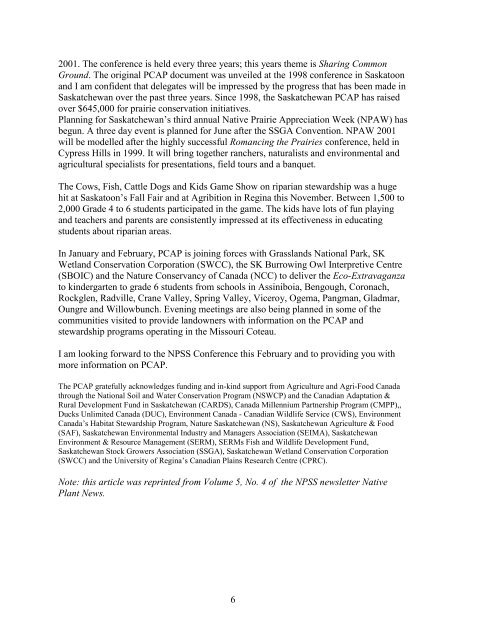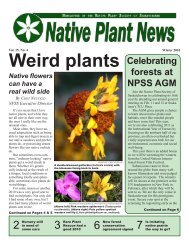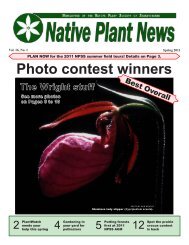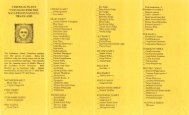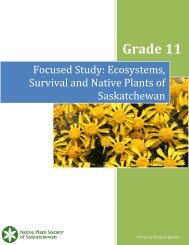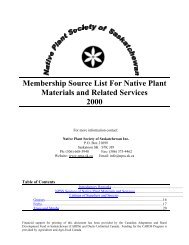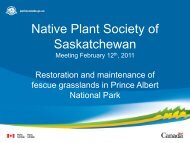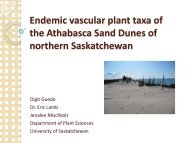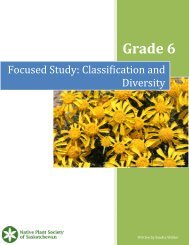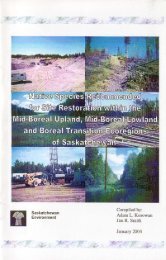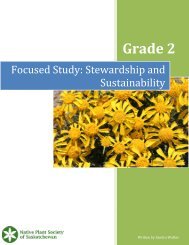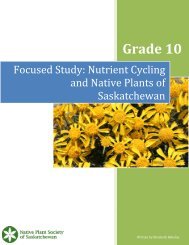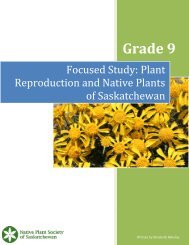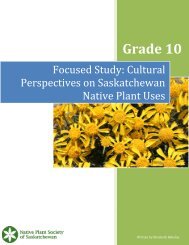Native Plants As Habitat For Wildlife - Native Plant Society of ...
Native Plants As Habitat For Wildlife - Native Plant Society of ...
Native Plants As Habitat For Wildlife - Native Plant Society of ...
Create successful ePaper yourself
Turn your PDF publications into a flip-book with our unique Google optimized e-Paper software.
2001. The conference is held every three years; this years theme is Sharing Common<br />
Ground. The original PCAP document was unveiled at the 1998 conference in Saskatoon<br />
and I am confident that delegates will be impressed by the progress that has been made in<br />
Saskatchewan over the past three years. Since 1998, the Saskatchewan PCAP has raised<br />
over $645,000 for prairie conservation initiatives.<br />
Planning for Saskatchewan’s third annual <strong>Native</strong> Prairie Appreciation Week (NPAW) has<br />
begun. A three day event is planned for June after the SSGA Convention. NPAW 2001<br />
will be modelled after the highly successful Romancing the Prairies conference, held in<br />
Cypress Hills in 1999. It will bring together ranchers, naturalists and environmental and<br />
agricultural specialists for presentations, field tours and a banquet.<br />
The Cows, Fish, Cattle Dogs and Kids Game Show on riparian stewardship was a huge<br />
hit at Saskatoon’s Fall Fair and at Agribition in Regina this November. Between 1,500 to<br />
2,000 Grade 4 to 6 students participated in the game. The kids have lots <strong>of</strong> fun playing<br />
and teachers and parents are consistently impressed at its effectiveness in educating<br />
students about riparian areas.<br />
In January and February, PCAP is joining forces with Grasslands National Park, SK<br />
Wetland Conservation Corporation (SWCC), the SK Burrowing Owl Interpretive Centre<br />
(SBOIC) and the Nature Conservancy <strong>of</strong> Canada (NCC) to deliver the Eco-Extravaganza<br />
to kindergarten to grade 6 students from schools in <strong>As</strong>siniboia, Bengough, Coronach,<br />
Rockglen, Radville, Crane Valley, Spring Valley, Viceroy, Ogema, Pangman, Gladmar,<br />
Oungre and Willowbunch. Evening meetings are also being planned in some <strong>of</strong> the<br />
communities visited to provide landowners with information on the PCAP and<br />
stewardship programs operating in the Missouri Coteau.<br />
I am looking forward to the NPSS Conference this February and to providing you with<br />
more information on PCAP.<br />
The PCAP gratefully acknowledges funding and in-kind support from Agriculture and Agri-Food Canada<br />
through the National Soil and Water Conservation Program (NSWCP) and the Canadian Adaptation &<br />
Rural Development Fund in Saskatchewan (CARDS), Canada Millennium Partnership Program (CMPP),,<br />
Ducks Unlimited Canada (DUC), Environment Canada - Canadian <strong>Wildlife</strong> Service (CWS), Environment<br />
Canada’s <strong>Habitat</strong> Stewardship Program, Nature Saskatchewan (NS), Saskatchewan Agriculture & Food<br />
(SAF), Saskatchewan Environmental Industry and Managers <strong>As</strong>sociation (SEIMA), Saskatchewan<br />
Environment & Resource Management (SERM), SERMs Fish and <strong>Wildlife</strong> Development Fund,<br />
Saskatchewan Stock Growers <strong>As</strong>sociation (SSGA), Saskatchewan Wetland Conservation Corporation<br />
(SWCC) and the University <strong>of</strong> Regina’s Canadian Plains Research Centre (CPRC).<br />
Note: this article was reprinted from Volume 5, No. 4 <strong>of</strong> the NPSS newsletter <strong>Native</strong><br />
<strong>Plant</strong> News.<br />
6


